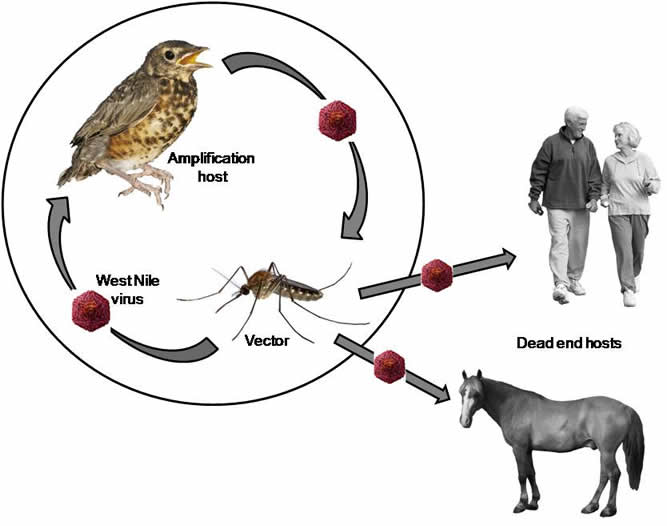|
|
|
|
|
|
|
WNV >
Information for Healthcare Professionals > Virus transmission cycle
|
|
WEST NILE VIRUS
|
|
|
|
|
|
|
|
|
|
|
WNV is locally maintained and dispersed in new areas primarily via an enzootic cycle of proliferation, which includes wild and domestic birds as reservoirs and ornithophilic mosquitoes (Culex spp.) as virus vectors. Apart from birds, the virus is transmitted to dead-end hosts as well.
The main transmission way for human infection is a bite from an infected mosquito.
Mosquitoes become infected when they feed on infected birds, as the virus circulate in their blood for a few days.
During later blood meals (when mosquitoes bite), the virus may be injected into humans and animals, where it can multiply and possibly cause illness, but cannot infect another mosquito due to low viremias (dead-end hosts).
Less common ways of transmission:
- contact with other infected animals, their blood, or other tissues.
- organ transplant
- blood transfusion
- breast milk
- reported case of transplacental (mother-to-child) WNV transmission
- transmission of WNV to laboratory workers has been reported
To date, no human-to-human transmission of WNV through casual contact has been documented. |
 |
The disease in birds:
Usual symptoms include depression, anorexia, decreased defecation, inability to fly, gait disorders, as well as bleeding from the mouth and the cloaca and death. Sensitive species exhibit macroscopic and histopathological lesions such as congestion of the cerebral cortex, the spleen (splenomegaly was observed in some cases), heart and kidneys, dotted hemorrhages in the stomach, liver and skeletal muscle, gallbladder distension and opaque air sacs.
Transmission cycle and mosquitoes:
The infection of a suitable vertebrate host with WNV begins with its detection by female mosquitoes. After this initial stage, female mosquitoes search the skin of their host with their mouthparts until they locate a capillary to draw blood. The final destination of WNV within the female mosquito digestive track, once ingested in a blood meal, is the salivary gland. When receiving blood containing the virus, female mosquitoes may become infected for all their life span and thus potentially transmit WNV to multiple vertebrate hosts during successive blood meals.
The disease in equines:
Equine infections either from lineage 1 or from lineage 2 WNV strains, are often subclinical, causing seroconversion in the absence of clinical signs. In clinical cases there is a variety of symptoms ranging from transient neurologic deficits to fulminating fatal encephalitis.
Reported clinical signs in horses include fever, paraparesis or tetraparesis and ataxia that may be symmetric or asymmetric, recumbency and evidence of intracranial disease including vestibular or cerebellar ataxia and behavioural changes. These signs are not pathognomonic for WNV infection. In many clinical cases affected horses frequently show muscle fasciculation and tremors.
Analysis of a large outbreak in horses revealed that the most common clinical signs were ataxia, gait disorders, muscle fasciculation, depression, and recumbency.
As WNV enters for first time in a previously non-exposed equine population, mortality among horses that develop clinical disease may be up to 50%. In contrast, as the disease becomes endemic in the region, the mortality rate among diseased horses are dramatically decreased
|
|
|
|
|
|
|
|
|
|
|
|
This site has been produced for the needs of the "Integrated surveillance and control programme for West Nile virus and malaria in Greece” and represents the views of its authors. These views have not been adopted or in any way approved by the Special Service of Health & Social Solidarity and the European Commission and should not be construed as positions of the Special Service or the Commission. The Special Service does not guarantee the accuracy of the information contained on this website and does not have any responsibility for any use of this information.
|
|
|
|
 |
|